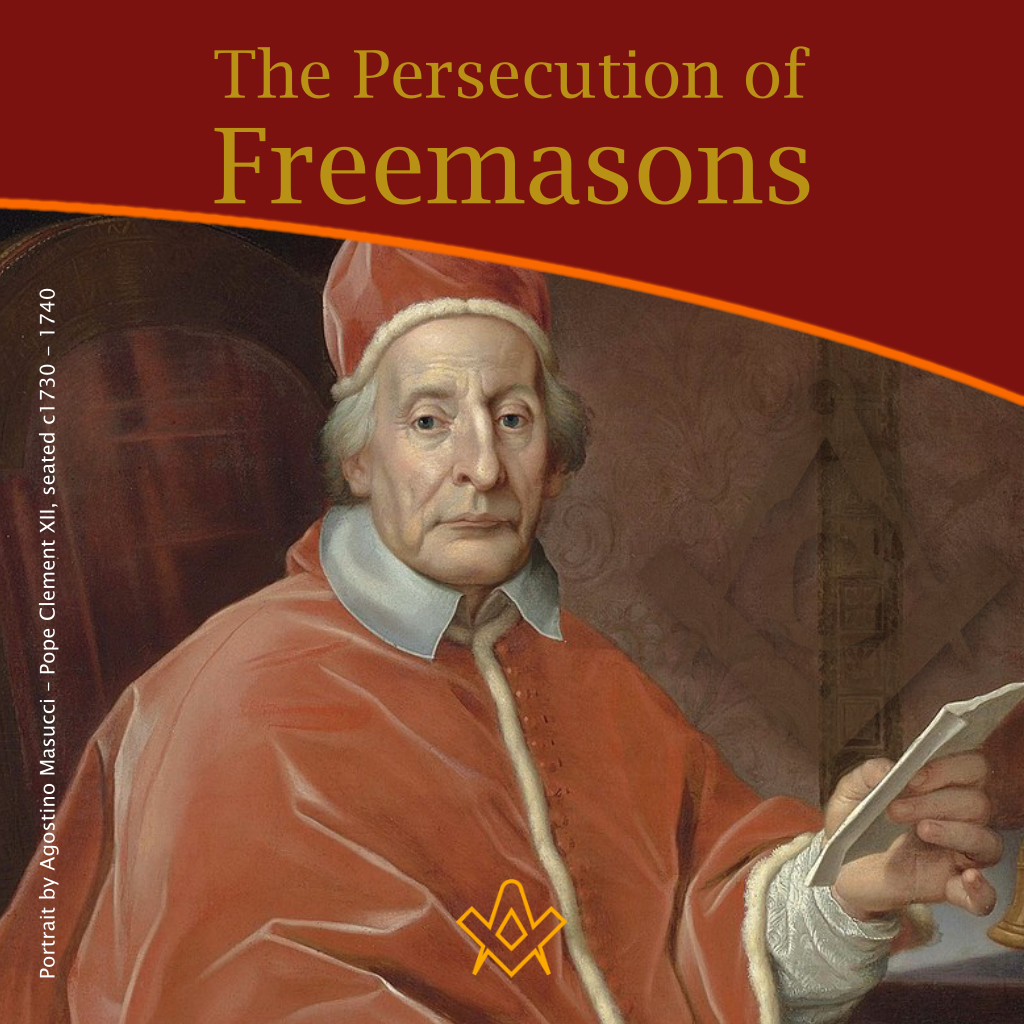Speculative Freemasonry, as practised by Grand Lodge of England, was officially born just over three hundred years ago, is today an international organisation, counting over six million members.
It has been subjected to persecution, suppression, and abolition throughout its history. In its infancy, only a couple of decades after its official birth, it had already become a target.
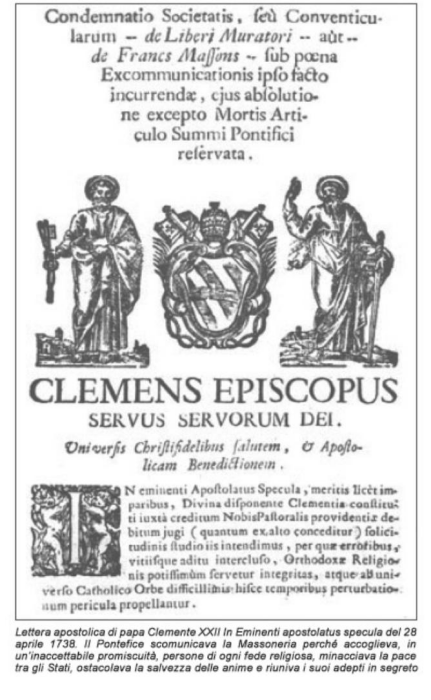
‘In eminenti apostolatus specula’ – Papal Bull issued in 1738 by Pope Clement XII prohibiting Masonic association.
IMAGE LINKED: https://threadreaderapp.com Attribution 4.0 International (CC BY 4.0)
One of the early attacks against Freemasonry took place in Italy. A lodge in Florence, which had been founded by an English Freemason and which accepted Italian members had been investigated by the Inquisition in 1736, only to be condemned a year later.
The same year in Paris, Andrew Michael Ramsay had given a speech at a Masonic meeting, a copy of which he had sent to a chief minister, Cardinal de Fleury, with a request to deliver the speech again at a Freemason’s assembly.
The cardinal accused Freemasons of treachery and banned any further assemblies. The Italian investigation and Cardinal’s ban, led Pope Clement XII, declaring the first canonical prohibition of any association with Freemasons in ‘In eminenti apostolatus specula’ (Projecting the apostolate).
As the reason for prohibiting Masonic association, Clement XII gives the following:
Members content with form of natural virtue are associated with one another by oaths with grave penalties to conceal in inviolable silence whatever they secretly do together.
In his act against the Masons, the Pope continues:
The rumour of activities among these men has so grown, that are not consistent with provisions of either civil or canon law, since they harm the peace of the civil state and the spiritual salvation of the souls.
Since then, eleven popes had made pronouncements that Catholic doctrines and Freemasonry are incompatible.
Until 1983, Catholics who publicly associated with, or publicly supported Masonic organizations were faced with automatic excommunication.
The present position of the Catholic Church is the 1983 Declaration on Masonic Associations, which states that Catholics “who enroll in Masonic associations are in a state of grave sin and may not receive Holy Communion.”
While the Church held its continued anti-Masonic position from the very start, other suppressions of Freemasonry emerged sporadically for shorter or longer periods of time.
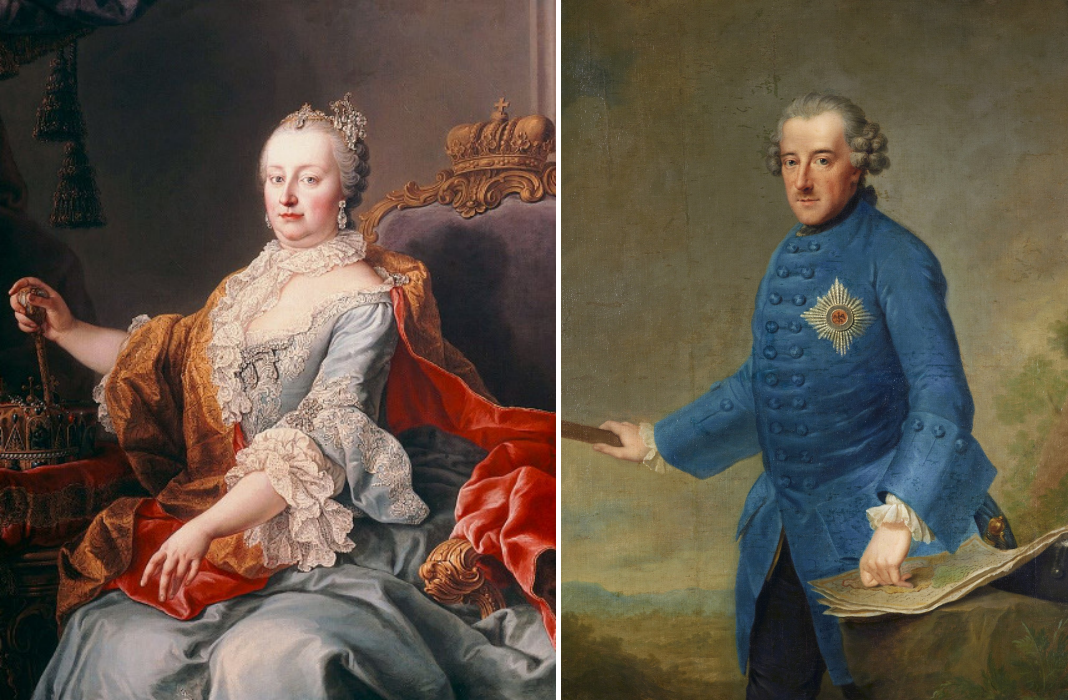
Left: Empress Maria Theresa
Right: King Frederick the Great
IMAGE LINKED: wikimedia Attribution 4.0 International (CC BY 4.0)
The Habsburg Monarchy had its own share of suppression of Freemasonry. The ban that took place during the reign of Her Royal Highness Empress Maria Theresa was due to continuous wars between Austria and Prussia.
In the Austrian war of Succession, the Prussian King Frederick the Great, a public protector of Freemasonry and prominent Freemason himself, was seen as someone who could supplant Austrian throne, by infiltrating his power in Austria through the Austrian lodges.
On 7th of March 1743, under the order of Maria Theresa, the Vienna lodge “Aux Trois Canons” (The Three Canons/Tenets) was dismantled after being operative for only six months.
Most of the members, mostly higher officials of the Court, were imprisoned for short period. The last ones were freed on 19 March.
Although Maria Theresa opposed Freemasonry, her husband Emperor Francis I and other members of the family were Masons themselves. With time the Empress softened her stance towards the Masons.
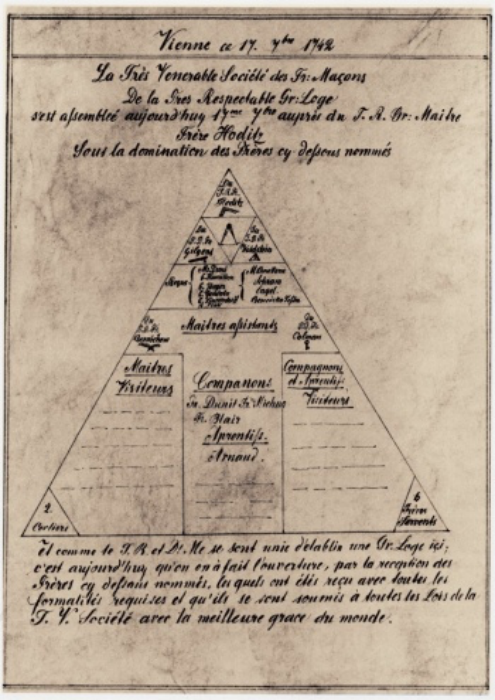
Charter of incorporation of the Lodge “Aux Trois Canon” [The Three Canons]
IMAGE LINKED: freimaurer-wiki.de Attribution 4.0 International (CC BY 4.0)
However, half a century later, a much longer prohibition of Freemasonry took place in Austria.
At that time, charlatans, alchemists, and mystics started joining the ranks of the Craft. Due to this fact in the year 1785, Maria Theresa’s son, Emperor Joseph II decided to reduce the number of consecrated lodges.
Two decades later, from fear of the intrusion of French-inspired revolutionaries, in 1793 the new Emperor Francis II finally forced the last two Vienna lodges to end their activities.
During the French occupation in 1809, there was a brief period of communication between French and Vienna lodges.
But for most of the 19th century and beginning of 20th, Austrian Freemasonry was officially non-existent. Up to 1918, several attempts were made in the parliamentary Upper House (Reichsrat) for the reinstatement of Freemasonry.
The collapse of the Austrian Empire in 1918, allowed Freemasonry to return and made the establishment of the Grand Lodge of Vienna possible in 1918.
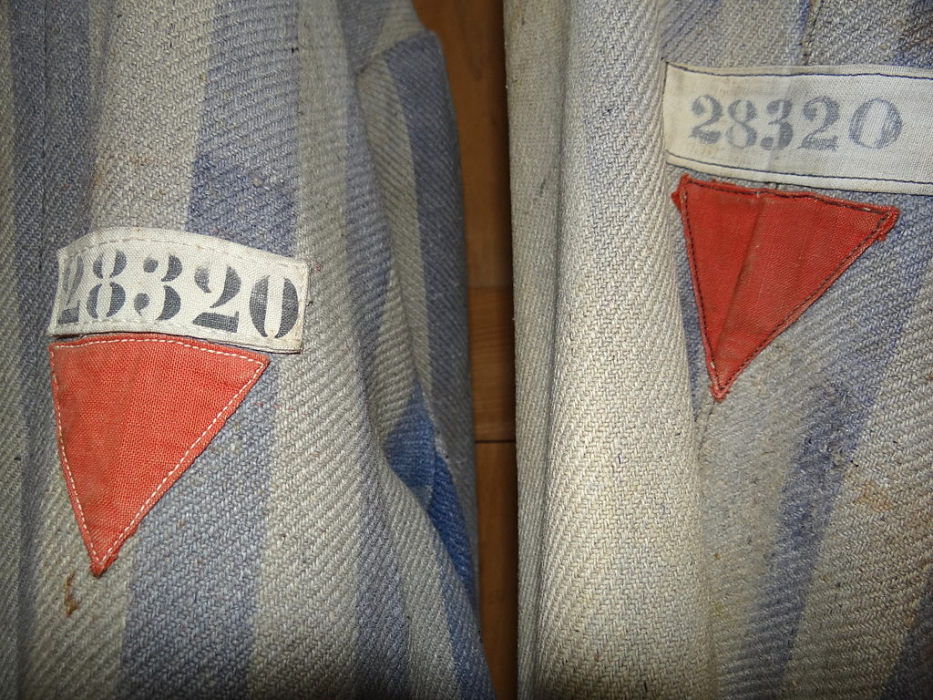
The Red Triangle worn by political prisoners in concentration camps – Freemasons were included in this group.
IMAGE LINKED: wikimedia Attribution 4.0 International (CC BY 4.0)
During the Nazi regime and World War II, Freemasonry in Germany and all countries that were either allied with the Nazis or under Nazi control, was banned by edict.
In ‘Mein Kampf’, Adolf Hitler wrote that Freemasonry was one of the causes of Germany’s defeat in WWI.
When Hitler came to power, in 1933, under the Enabling Act (Ermächtigungsgesetz) the German parliament ordered Freemasonry to be dissolved, the property of all lodges to be confiscated and those who had been members of lodges, were prohibited from holding office in the Nazi party and were not eligible to be appointed in public service.
In 1935, in the Nazi Party newspaper article, Hitler made accusations that a conspiracy between the Masonic Fraternity and the World Jewry was seeking to create a World Republic.
Also in concentration camps, Masonic inmates were considered political prisoners, and had to wear an inverted red triangle.
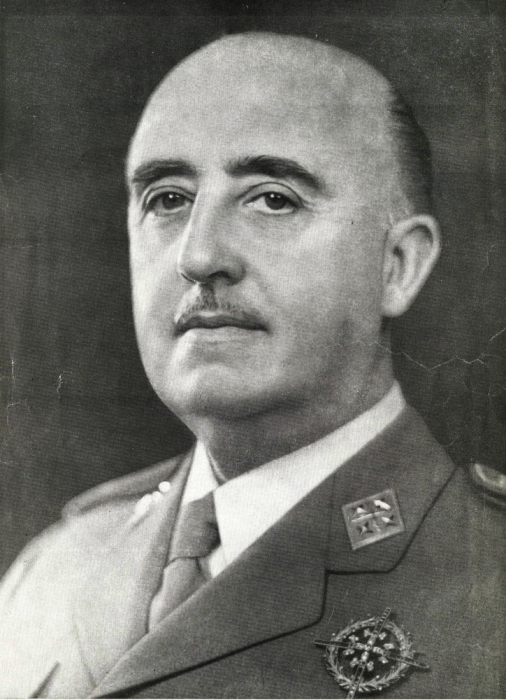
Francisco Franco Bahamonde, Spain’s fascist dictator from 1939-1975
IMAGE LINKED: wikimedia Attribution 4.0 International (CC BY 4.0)
In Spain, in 1928, 200 Freemasons were accused of plotting against the government. After the Spanish Nationalists’ coup of 1936, many Masons found in nationalist controlled areas were arrested and killed along with members of left-wing parties and trade unionists.
Working for the Nationalists and in effort to expose Freemasons, Father Juan Tusquets Terrats, together with Francisco Franco’s personal chaplain, assembled a huge index of 80,000 suspected Masons, although there were no more than 5,000 Masons in Spain.
In places such as Cordoba, Santa Cruz de Tenerife, Salamanca, Logrono, Ceuta, Algeciras, Valladolid, Lugo, Zamora, Cadiz and Granada, Masonic temples were burnt down, members of lodges were tortured, garrotted, shot and murdered. In Seville, the entire membership of several lodges was butchered.
The annual Masonic assembly held in Madrid noted that by 1937, all Masons that had not escaped from the areas under nationalist control had been murdered.
Freemasonry was officially outlawed from Spain in 1940. Masons were automatically punishable by a minimum jail term of 12 years and Masons above 18th degree even faced the death penalty.
Like Hitler’s references to a ‘Judeo-Masonic plot’, Francoist speeches carried the same reference as a standard component of propaganda. The Law for the Repression of Freemasonry and Communism was not abolished until 1963.
According to Franco: “The whole secret of the campaigns unleashed against Spain can be explained in two words: masonry and communism…we have to extirpate these two evils from our land.”
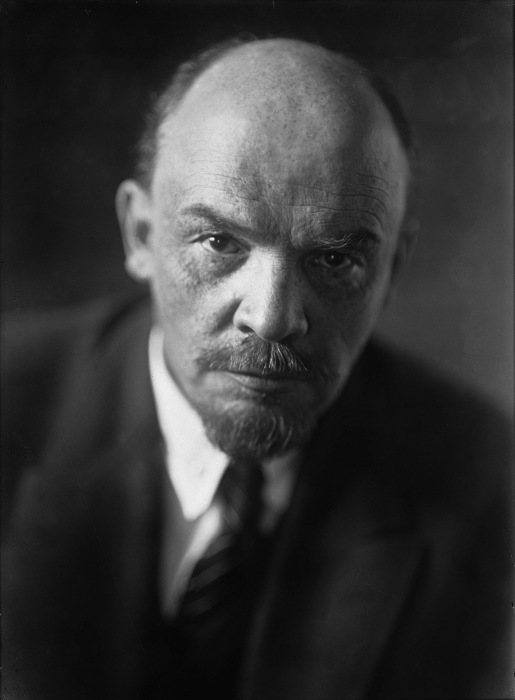
Vladimir Lenin (1870-1924), Russian Communist Revolutionary Leader from 1917-1924.
IMAGE LINKED: wikimedia Attribution 4.0 International (CC BY 4.0)
Communist leaders held their own views regarding the Masons. Most parties of the Second International (1889-1916) had a view that socialism and Freemasonry are incompatible.
At the Second Congress of the Third Communist International, members did not address the issue of incompatibility as by then it was taken for granted. After the 1917 revolution in Russia, Vladimir Leninbanned Freemasonry.
The soviet authorities took a firm stance as they considered it to be part of the bourgeoisie establishment.
The Bolsheviks dealt harshly with anything that resembled Masonic associations. Russian Masons had to emigrate from Russia.
In 1922, at the Fourth Congress, the Communist International discovered that a number of French communists had joined Masonic lodges. On learning of this fact, the Fourth Congress adopted resolution that Freemasons could not be members of the Communist Party.
Contacts of communist members with Masons were regarded equivalent to contacts with a secret enemy organisation.
The decision of the congress was that Freemasonry was the most dishonest notorious deceit against the proletariat, headed by radical the bourgeoisie.
With this resolution, the Comintern wanted to cut compromising ties of French party functionaries with the Masonic lodges.
From 1922 onwards, Freemasonry did not exist in the Soviet Union or its satellite states, Albania, Poland, Bulgaria, Romania, Czechoslovakia, Hungary, and East Germany.
After the fall of Iron Curtain in 1995, the Grand Lodge of Russia was reconstituted under the sponsorship of the Grande Loge Nationale Francaise.
Former Soviet satellite states had their own Masonic resurrections in 1990s.
Yugoslavia was not a Soviet satellite state, but the post WWII communist leadership of Yugoslavia shared the same attitude toward Freemasonry as did the Communist International.
Freemasonry was forbidden throughout the period of socialist rule. After almost 50 years of inactivity, Yugoslavian Grand lodge was resurrected in 1990.
With the subsequent division within Yugoslavia, into separate entities, each newly independent, sovereign, ex republic now boasts its own Grand Lodge.
The United States also witnessed unsavoury sentiment against Masons. During the period of Industrial Revolution in the late 18th century, as people began to move toward new western states, the political and social unrest resulting from the weakening of family orientated and tight community traditions, gave growth to the anti-Masonic sentiment.
Historian Paul Goodman notes:
“Anti-Masons were responding to the emergence of industrial society, which clashed with the remnants of pre-industrial order.”
In those changing times, Freemasonry was one of the few institutions that remained stable.
As such it became a natural target for protesters. In New York in 1826, the disappearance of William Morgan, a man who threatened to publish an exposé titled Illustrations of Masonry, added fuel to the fire.
His disappearance caused some anti-Masons to claim that Masons had kidnapped and murdered him. The following protests eventually manifested into political realm.

William Morgan
IMAGE LINKED: wikimedia Attribution 4.0 International (CC BY 4.0)
Under the leadership of a newspaper publisher Thurlow Weed, the Anti-Masonic party came to existence in upstate New York in February 1828.
The party believed that Freemasonry was a corrupt and elitist society that ruled most of the country. The party was also a movement against President Andrew Jackson who was a high-ranking Mason and frequently spoke of the organisation with praise.
Weed allegedly stated that a corpse found floating in the Niagara River was “a good enough Morgan”, statement which he denied after the 1828 elections.
The Anti-Masonic Party ran presidential candidates for two election terms, but by 1835 it was dismantled everywhere except in Pennsylvania. The second incarnation of Anti-Masonic party took place in 1872 when the National Christian Association reorganized the party.
The new platform of the Anti-Masonic Party espoused Christianity, temperance, the abolition of secret societies. It had more religious basis and was active for 16 years only.
In the United Kingdom, Freemasonry suffered damage under the Unlawful Societies Act of 1799.
Fearing the French invasion and averting a repetition of the revolution, the act was the government’s response to seditious societies bound by secret oaths. Societies, whose members were required to take an oath which was not authorised by law, were deemed illegal.
The Grand Master of the Antients and the Acting Grand Master of the Moderns negotiated a clause to be added into the legislation.
The clause was in favour of the societies ‘held under the denomination of lodges of Freemasons’, if they met the conditions that they were in existence before the Act, with their names, places, and times of meetings, as well as the names of their members registered annually. The Act was finally repealed in 1967.
Due to accusations of favour swapping, the British Government tried bringing into law the requirement that Freemasons joining the police or judiciary would have to declare their memberships of the Craft publicly.
In 1999, Welsh Assembly made this a legal requirement, whereas in England the requirement was to remain voluntary.
While various secular movements, political systems and regimes across the globe criticised Freemasonry, those anti-Masonic sentiments eventually disappeared in turn with their dissolution.
On the other hand, religions such as Christianity, continue to hold anti-Masonic sentiment. The religion of Islam views Freemasonry in a similar fashion. Soon after the Pope’s condemnation, the ruler of Ottoman Empire, Sultan Mahmud II, took steps in banning Freemasonry branding it an atheistic organisation.
Freemasonry has been outlawed in most of the Arab world ever since. In 1978, the Islamic Jurisdictional College declared Freemasonry to be “dangerous” and “clandestine”.
Most of the Islamic anti-sentiment is attached to the conviction that Freemasonry works towards achieving the goals of Zionism and promotes the interests of Jews around the world.
After the 1958 revolution, Iraq was an example with the introduction of laws against any Masonic associations. Later, when Saddam Hussein took power, the position towards Freemasonry was reinforced. In his view, those who promoted Zionist principles or who associated themselves with Zionist organisations, faced death penalty.
Freemasonry was not excluded. Although today, Masonry is illegal in most of the Muslim world, countries such as Turkey and Morocco do have an active Masonic life with their own established Grand Lodges, while Malaysia, and Lebanon work through District Grand Lodges operating under a warrant from an established Grand Lodge.
Part of a Masonic foundation rests on the principle of members not discussing any political or religious matters.
Men from all walks of life, regardless of their religious and political outlook, joined together as brothers through institution of Freemasonry.
Within this organisation, alongside each other they could put aside their differences, work together, work on themselves and their personal growth, to be exemplary in the discharge of their civil duties, by never proposing, or at all countenancing, any act that may have had a tendency to subvert the peace and good order of society.
Unfortunately, not all who joined learned the foundations on which Masonry rests – the practice of every social and moral value.
The history gives examples such as one of Empress Maria Theresa, which rightfully or not points to her view of the Masonic lodges as King Frederick’s breeding grounds for plots and machinations against her empire.
Or an example of William Morgan case. A mindset of overprotective and over-passionate Freemasons, who brought forth an act, which goes against the very civil duties they were meant to uphold.
How many more cases are there, branding us against our own virtuous and noble claims?
How many of us have not mastered the lessons of becoming better men?
How many have joined in order to exploit the institution for their personal gain?
How many have brought bad publicity, by hiding under the veil of a Freemason?
How many times have individuals given justifications to the outsiders to mercilessly persecute the rest?
Over three hundred years ago, a New United Grand Lodge of speculative Masons entered a period of self-publicity.
The beginnings were open, with initiations reported in newspapers and installations of the new Grand Master an occasion for a parade. With the expansion of speculative Masonry, there was also a corresponding climb in anti-Masonic publications.
Handful of scandals, misconceptions and hoaxes branded Masonry as suspicious. With time, suspiciousness had only been reinforced by secrecy. Maybe the secrecy was a necessity through different periods, but is this still the case today?
In the era of technological communication, isn’t this secrecy a plague?
Being closed off from the outside world only keeps the distorted and negative image of Freemasonry alive.
As Freemasons celebrated the tercentenary of their existence, they were not left without challenges.
The past teaches that any present and future ideological systems-organisations and schools of thought across the globe, desiring to join anti-masonic bandwagon, will bring Freemasonry into confrontations.
Brethren across the face of the earth need only listen to the annual “Address to the Brethren” at their Craft lodge installation in order to remind themselves of the wonderful job they do:
by spreading the message of peace and tolerance,
by assisting their fellowmen in time of need and by looking out for the less fortunate;
by comforting those who need comfort,
by facilitating, learning and educating, communicating happiness, spreading joy and giving hope.
It is a Mason’s duty and the duty of future Masonic generations to endure confrontations by applying those teachings in their daily lives.
Masons of today also have a duty of removing the veil of secrecy, showing the outside world who they are, and the values and morals they stand for.
Perhaps in time, the ignorance of those who are not Freemasons or supporters, who are kept in state of darkness, will have predominant wish to see the light and the true nature of those who are Freemasons.
Article by: Alex Lishanin
..
Recent Articles: masonic history
 Protestantism and Masonic Influence in Brazil Discover the untold story of how Freemasons helped Southern Americans immigrate to Brazil post-Civil War, fostering economic and educational growth in Santa Bárbara d’Oeste and Americana. Learn about their pivotal role in establishing Protestant churches and ensuring the secularity of the Brazilian State amidst a Catholic-dominated society. |
 Explore the proper use of the sacred word in Brazilian Freemasonry through an analysis of Masonic literature and Bible translations. Uncover the errors in pronunciation and the need for corrections to maintain liturgical coherence in rituals. Discover insights on Masonry, rituals, and the Hebrew word Boaz. |
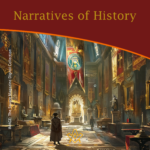 Narratives of History |
 A Very Royal Sesquicentenary |
 Unveiling the Enigma: Discover the Royal Society's Legacy and its Impact on Science. Delve into the fascinating history of the Royal Society, the prestigious UK academy shaping scientific progress since 1660. Explore its pivotal role in advancing knowledge, fostering collaboration, and unlocking the secrets of the universe. Prepare to be amazed! |
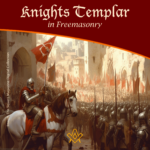 Knights Templar in Freemasonry Uncover the Mysteries of the Knights Templar in Freemasonry! Delve into the intriguing world where chivalry and symbolism intertwine. Discover the captivating rituals and ancient secrets behind the Knights Templar Masonic Orders. Explore the historical connection and delve into the enigmatic narratives that continue to fascinate enthusiasts today. Unveil the hidden truths now! |
 The Royal Arch stands as the rainbow of promise in the Ritual; it stands as the promise of the resurrection; of that which was lost and that it shall be recovered. The question arises as to whether the Master's Word was originally communicated in the Third Degree? On this point there is some diversity of opinion. Originally published in 1915, this insight into the Fourth Degree – the Holy Royal Arch – is as relevant today as it was over 100 years ago. |
 Unveiling the Mysteries of Druidism: Discover the Intriguing Connection with Freemasonry. Explore the ancient spiritual practice of Druidism and its fascinating ties to the enigmatic world of Freemasonry. Delve into the shared symbolism and rituals that have captivated minds for centuries. Unlock the secrets of these intertwined traditions today! |
 Uncover the legacy of freestone masons and their pivotal role in crafting medieval cathedrals. Discover the artistry behind their techniques, the hierarchy within their craft, and the enduring impact of their intricate carvings. A deep dive into the world of these master craftsmen awaits you! |
 Unearth the intriguing journey from Vincha Culture to Freemasonry. Discover how ancient building methods intertwine with modern Masonic philosophies. This exploration will shed light on the fascinating link between the Serbian term "shestarenye" and the symbolic significance of the compass in Freemasonry. |
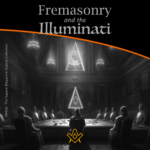 Freemasonry and the Illuminati Unravel the enigmatic world of Freemasonry and the Illuminati in our latest exposé. Dive into centuries-old mysteries, debunk conspiracy theories, and discover the truth behind these elusive societies. Are they puppet masters or mere myths? Join us as we dissect history and fact from fiction. |
 The Île des Templiers, or “Island of the Templars” lies within a leafy park in Paris. The execution site of Jacques du Molay, the last Grand Master of the Knights’ Templar bears a plaque with the epitaph ‘A cet endroit / Jacques de Molay / Dernier grand maître / de l'ordre du temple / a été brûlé le 18 Mars 1314’ (‘In this location / Jacques de Molay / Last grand master / of the order of the temple / was burned on 18 March 1314’) |
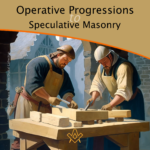 Operative Progressions to Speculative Masonry Both Operative and Speculative Masonry are an important part of the modern fraternity of Freemasonry, which combines elements of both traditions. Today, Freemasonry is a fraternity that is open to men of good character, who are interested in personal development and in making a positive contribution to their communities. |
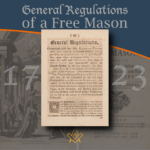 General Regulations of a Free Mason, 1723 General Regulations of a Free Mason as contained in Anderson's Constitutions of the Freemasons, published 1723. the Regulations are of great historical interest. Compiled by George Payne, the second Grand Master of the Premier Grand Lodge of England, they were printed in 1722/3, thus published just over five years after the formation of the Grand Lodge 1717. |
 The Genesis of the 1723 Book of Constitutions 2023, marks the three hundredth anniversary of the publication of the first printed Book of Constitutions of the Grand Lodge formally established in London two years previously. This is an anniversary whose significance extends beyond freemasonry. A paper by Andrew Prescott |
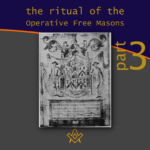 The Ritual of the Operative Free Masons - P3 Existing Operative Free Masons. The ritual I am about to refer, is that of "The Worshipful Society of Free Masons, Rough Masons, Wallers, Slaters, Paviors, Plaisterers, and Bricklayers." By Thomas Carr, M.D., P. M. Honorary Member of the Guild of Operative Free Masons |
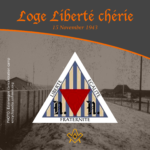 Liberté chérie was a Masonic Lodge founded in 1943 by Belgian Resistance fighters and other political prisoners at Esterwegen concentration camp. It was one of the few lodges of Freemasons founded within a Nazi concentration camp during the Second World War. |
 The Ritual of the Operative Free Masons - P2 If anyone doubts the fact that the formation of Speculative Free Masonry was due to and based upon Operative Free Masonry, it is quite easy to convince him of his error if he will only study the first Book of Constitutions. By Thomas Carr, M.D., P. M. Honorary Member of the Guild of Operative Free Masons |
 In 1881, Freemasonry rose from the ashes of a fire in the mining town of Kokomo, Summit County, Colorado. Corinthian Lodge No. 42, along with Kokomo, no longer exists but it holds the record of having been – at an elevation of 10,618 feet – the highest Masonic Lodge in the USA. |
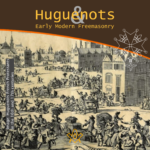 The Huguenots and Early Modern Freemasonry The Huguenots influence in the development of early modern Freemasonry at the time of the formation of the Grand Lodge in London around 1717 / 1723. |
 November is a month of reflection – perhaps due to the fact that we are getting close to the years' end – but also because Remembrance / Armistice Day (11 November) is a significant date in most countries' diaries. |
 Speculative Freemasonry, as practise by Grand Lodge of England, was officially born just over three hundred years ago, is today an international organisation, counting over six million members. It has been subjected to persecution, suppression, and abolition throughout its history. In its infancy, only a couple of decades after its official birth, it had already become a target. |
 The Ritual of the Operative Free Masons - P1 The original paper was written, first, to prove that Speculative Free Masonry was derived from Operative Free Masonry; second, to give some account of the Operative Free Masons, of their Ritual, and of their customs. By Thomas Carr, M.D., P. M. Honorary Member of the Guild of Operative Free Masons |
 American Fraternalism in the 19th and Early 20th Centuries The late 19th and early 20th centuries in the United States has been called the "Golden Age of Fraternalism." How did this come about and why was the idea of joining a fraternal organization so popular? We will explore this question and examine the regalia used by many fraternal organizations in this period. |
 Societas Draconistarum, meaning "Society of the Dragonists"– was a chivalric Order for selected nobility, founded in 1408 by Sigismund von Luxembourg, who through marriage became the King of Hungary (1387–1437) and later Holy Roman Emperor. The Order was fashioned after the military orders of the Crusades, requiring its initiates to defend the cross and fight the enemies of Christianity, in particular the Ottoman Empire. |
 The Perjured Free Mason Detected Was Samuel Prichard a perjured individual, or simply a misguided Freemason? Prichard's book "Free Masonry Dissected" published in 1730, is now used by many Masonic historians as a source of reference with regards to the introduction of the third degree into the Craft. But at the time it was published in 1730, it was not so well received by members of the Grand Lodge of England. |
 17th century and the Holy Royal Arch This article focuses on a period of transition between a point in time when we can safely and historically identify the first formation of what could be called as the ‘Royal Arch’ and the historical events that have preceded it. |
 Most Freemasons have heard the terms 'Operative' and 'Speculative' Masons, and this article helps to understand the difference: |
 Roberts' Constitutions of Freemasonry 1722 Published a year before Anderson's Constitutions, The Old Constitutions Belonging to the Ancient and Honourable SOCIETY OF Free and Accepted MASONS. Originally printed in London England; Sold by J. Roberts, in Warwick-Lane, MDCCXXII.(1722) |
 From 'Songs of religion and life', 1876 by John Stuart Blackie (1809-1895) |
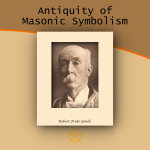 On the Antiquity of Masonic Symbolism Is the Symbolism of Masonry an inheritance derived from the old Masons who flourished before the era of the Grand Lodges (1717); or has it been borrowed from the Rosicrucians or others, after 1717? |
 Mason's Marks – from Egypt to Europe? Mason's marks have been a source of intrigue, not only to Freemasons but to historians and archaeologists. The use of simple pictograms have been employed for millennia by artisans to identify their work. But where did they originate and why? |
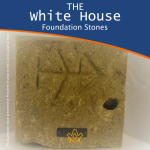 The White House Foundation Stones Further to the articles in our series on the history of the stone masons, we have a rather intriguing addition. During the 1950's renovation of the White House, President Truman retrieved more than 100 stone blocks with stonemasons marks. |
 What the Goose and Gridiron Tavern is in the ancient annals of London Freemasonry, The Green Dragon Tavern is to the memories of the Free-mason, of Boston and New England. |
 Auschwitz concentration camp: video photo article taken in 2013 |
 There are two things of importance happening this day - 27 January |
 Two approaches regarding the understanding of Freemasonry |
 Masonic Research in England c1930 An article which appeared in an American Masonic magazine, c1930 and which was reproduced in England, provoking a little controversy. |
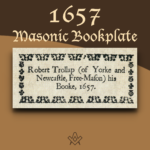 Masonic bookplates the ‘Brethren’s spiritual coats of arms and marks’ |
 The Unlawful Societies Act of 1799 Rebellious Freemasons and the 21st century |
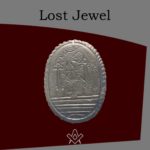 In 1912, Sarah Dowd of Dromore, Ireland, found a Masonic jewel dated 1517 - a date two hundred years before the establishment of Grand Lodge... |
 Freemasonry and Fascist Regime Interesting speech by the famous historian Prof. Aldo A. Mola, who links the fascist regime with the Masonic Associations. |
 Was famous Russian poet Alexander Pushkin a Freemason? And if so, was he a member of the lodge ‘for which all the lodges in Russia were destroyed’? |
 The Importance of Masonic Research Why is accurate - or authentic - Masonic research so important? The importance of making a daily advancement in Masonic knowledge is something that The Square is passionate about promoting. |
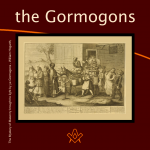 The Antient Noble Order of the Gormogons had a brief existence in the eighteenth century; they left few records or accomplishments, |
masonic knowledge
to be a better citizen of the world
share the square with two brothers

click image to open email app on mobile device


